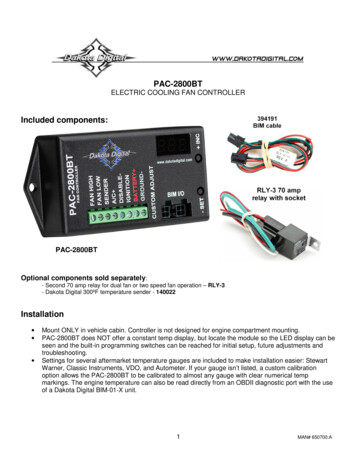
Transcription
312J. Opt. Soc. Am. A / Vol. 31, No. 2 / February 2014Akkaynak et al.Use of commercial off-the-shelf digital cameras forscientific data acquisition and scene-specificcolor calibrationDerya Akkaynak,1,2,3,* Tali Treibitz,4 Bei Xiao,5 Umut A. Gürkan,6,7Justine J. Allen,3,8 Utkan Demirci,9,10 and Roger T. Hanlon3,111Department of Mechanical Engineering, MIT, Cambridge, Massachusetts 02139, USAApplied Ocean Science and Engineering, Woods Hole Oceanographic Institution, Woods Hole,Massachusetts 02543, USA3Program in Sensory Physiology and Behavior, Marine Biological Laboratory, Woods Hole,Massachusetts 02543, USA4Department of Computer Science and Engineering, University of California, San Diego, La Jolla,California 92093, USA5Department of Brain and Cognitive Science, MIT, Cambridge, Massachusetts 02139, USA6Case Bio-manufacturing and Microfabrication Laboratory, Mechanical and Aerospace Engineering Department,Department of Orthopedics, Case Western Reserve University, Cleveland, Ohio 44106, USA7Advanced Platform Technology Center, Louis Stokes Veterans Affairs Medical Center, Cleveland,Ohio 44106, USA8Department of Neuroscience, Brown University, Providence, Rhode Island 02912, USA9Bio-Acoustic-MEMS in Medicine Laboratory, Center for Biomedical Engineering,Renal Division and Division of Infectious Diseases, Department of Medicine, Brigham andWomen’s Hospital, Harvard Medical School, Boston, Massachusetts 02115, USA10Harvard-MIT Health Sciences and Technology, Cambridge, Massachusetts 02139, USA11Department of Ecology and Evolutionary Biology, Brown University, Providence,Rhode Island 02912, USA*Corresponding author: deryaa@mit.edu2Received July 12, 2013; revised November 13, 2013; accepted December 5, 2013;posted December 6, 2013 (Doc. ID 193530); published January 20, 2014Commercial off-the-shelf digital cameras are inexpensive and easy-to-use instruments that can be used for quantitativescientific data acquisition if images are captured in raw format and processed so that they maintain a linear relationshipwith scene radiance. Here we describe the image-processing steps required for consistent data acquisition with colorcameras. In addition, we present a method for scene-specific color calibration that increases the accuracy of colorcapture when a scene contains colors that are not well represented in the gamut of a standard color-calibration target.We demonstrate applications of the proposed methodology in the fields of biomedical engineering, artwork photography, perception science, marine biology, and underwater imaging. 2014 Optical Society of AmericaOCIS codes: (110.0110) Imaging systems; (010.1690) Color; (040.1490) Cameras; (100.0100) Image 121. INTRODUCTIONState-of-the-art hardware, built-in photo-enhancementsoftware, waterproof housings, and affordable prices enablewidespread use of commercial off-the-shelf (COTS) digitalcameras in research laboratories. However, it is oftenoverlooked that these cameras are not optimized for accuratecolor capture, but rather for producing photographs that willappear pleasing to the human eye when viewed on smallgamut and low dynamic range consumer devices [1,2]. Assuch, use of cameras as black-box systems for scientificdata acquisition, without control of how photographs aremanipulated inside, may compromise data accuracy andrepeatability.A consumer camera photograph is considered unbiased if ithas a known relationship to scene radiance. This can be a1084-7529/14/020312-10 15.00/0purely linear relationship or a nonlinear one where the nonlinearities are precisely known and can be inverted. A linearrelationship to scene radiance makes it possible to obtaindevice-independent photographs that can be quantitativelycompared with no knowledge of the original imaging system.Raw photographs recorded by many cameras have thisdesired property [1], whereas camera-processed images, mostcommonly images in jpg format, do not.In-camera processing introduces nonlinearities throughmake- and model-specific and often proprietary operationsthat alter the color, contrast, and white balance of images.These images are then transformed to a nonlinear RGB spaceand compressed in an irreversible fashion (Fig. 1). Compression, for instance, creates artifacts that can be so unnaturalthat they may be mistaken for cases of image tampering 2014 Optical Society of America
Akkaynak et al.Vol. 31, No. 2 / February 2014 / J. Opt. Soc. Am. A313Fig. 1. Basic image-processing pipeline in a consumer camera.(Fig. 2) [3]. As a consequence, pixel intensities in consumercamera photographs are modified such that they are no longerlinearly related to scene radiance. Models that approximateraw (linear) RGB from nonlinear RGB images (e.g., sRGB)exist, but at their current stage they require a series of trainingimages taken under different settings and light conditions aswell as ground-truth raw images [2].The limitations and merit of COTS cameras for scientificapplications have previously been explored, albeit disjointly,in ecology [4], environmental sciences [5], systematics [6],animal coloration [7], dentistry [8], and underwater imaging[9,10]. Stevens et al. [7] wrote: “. most current applicationsof digital photography to studies of animal coloration fail toutilize the full potential of the technology; more commonly,they yield data that are qualitative at best and uninterpretableat worst.” Our goal is to address this issue and make COTScameras accessible to researchers from all disciplines asproper data-collection instruments. We propose a simpleframework (Fig. 3) and show that it enables consistent colorcapture (Sections 2.A–2.D). In Section 3, we introduce theidea of scene-specific color calibration (SSCC) and showthat it improves color-transformation accuracy when a nonordinary scene is photographed. We define an ordinary sceneas one that has colors within the gamut of a commerciallyavailable color-calibration target. Finally, we demonstratehow the proposed workflow can be applied to real problemsin different fields (Section 4).Throughout this paper, “camera” will refer to “COTS digitalcameras,” also known as “consumer,” “digital still,” “trichromatic,” or “RGB” cameras. Any references to RGB will mean“linear RGB,” and nonlinear RGB images or color spaces willbe explicitly specified as such.2. COLOR IMAGING WITH COTS CAMERASColor vision in humans (and other animals) is used to distinguish objects and surfaces based on their spectral properties.Normal human vision is trichromatic; the retina has threecone photoreceptors referred to as short (S, peak 440 nm),Fig. 3. Workflow proposed for processing raw images. Consumercameras can be used for scientific data acquisition if images are captured in raw format and processed manually so that they maintain alinear relationship to scene radiance.medium (M, peak 545 nm), and long (L, peak 580 nm). Multiplelight stimuli with different spectral shapes evoke the sameresponse. This response is represented by three scalarsknown as tri-stimulus values, and stimuli that have the sametri-stimulus values create the same color perception [11].Typical cameras are also designed to be trichromatic; theyuse color filter arrays on their sensors to filter broadband lightin the visible part of the electromagnetic spectrum in regionshumans perceive as red (R), green (G), and blue (B). Thesefilters are characterized by their spectral sensitivity curves,unique to every make and model (Fig. 4). This means thattwo different cameras record different RGB values for thesame scene.Human photoreceptor spectral sensitivities are often modeled by the color-matching functions defined for the 2 observer (foveal vision) in the CIE 1931 XYZ color space.Any color space that has a well-documented relationship toXYZ is called device-independent [12]. Conversion ofdevice-dependent camera colors to device-independent colorspaces is the key for repeatability of work by others; wedescribe this conversion in Sections 2.D and 3.A. Image Formation PrinciplesThe intensity recorded at a sensor pixel is a function of thelight that illuminates the object of interest (irradiance, Fig. 5),the light that is reflected from the object toward the sensor(radiance), the spectral sensitivity of the sensor, and opticsof the imaging system:ZI c k γ cos θiFig. 2. (a) An uncompressed image. (b) Artifacts after jpg compression: (1) grid-like pattern along block boundaries, (2) blurring due toquantization, (3) color artifacts, (4) jagged object boundaries. Photocredit: Dr. Hany Farid. Used with permission. See [3] for full resolution images.λmaxλminS c λ Li λ F λ; θ dλ:(1)Fig. 4. Human color-matching functions for the CIE XYZ color spacefor 2 observer and spectral sensitivities of two cameras; Canon EOS1Ds mk II and Nikon D70.
314J. Opt. Soc. Am. A / Vol. 31, No. 2 / February 2014Akkaynak et al.mosaic. At each location, the two missing intensities are estimated through interpolation in a process called demosaicing[14]. The highest-quality demosaicing algorithm availableshould be used regardless of its computation speed (Fig. 6),because speed is only prohibitive when demosaicing is carriedout using the limited resources in a camera, not when it isdone by a computer.Fig. 5. (a) Irradiance of daylight at noon (CIE D65 illuminant) andnoon daylight on a sunny day recorded at 3 m depth in the Aegean Sea.(b) Reflectance spectra of blue, orange, and red patches from aMacbeth ColorChecker (MCC). Reflectance is the ratio of reflectedlight to incoming light at each wavelength, and it is a physical propertyof a surface, unaffected by the ambient light field, unlike radiance.(c) Radiance of the same patches under noon daylight on land and(d) underwater.Here c is the color channel (e.g., RGB), S c λ is the spectralsensitivity of that channel, Li λ is the irradiance, F λ; θ is thebi-directional reflectance distribution function, and λmin andλmax denote the lower and upper bounds of the spectrumof interest, respectively [13]. Scene radiance is given byLr λ Li λ F λ; θ cos θi ;(2)where F λ; θ is dependent on the incident light direction aswell as the camera viewing angle where θ θi ; ϕi ; θr ; ϕr .The function k γ depends on optics and other imaging parameters, and the cos θi term accounts for the changes in theexposed area as the angle between surface normal and illumination direction changes. Digital imaging devices use differentoptics and sensors to capture scene radiance according tothese principles (Table 1).C. White BalancingIn visual perception and color reproduction, white has a privileged status [15]. This is because through a process calledchromatic adaptation, our visual system is able to discountsmall changes in the color of an illuminant, effectively causingdifferent lighting conditions to appear “white” [12]. For example, a white slate viewed underwater would still be perceivedas white by a SCUBA diver, even though the color of the ambient light is likely to be blue or green, as long as the diver isadapted to the light source. Cameras cannot adapt likehumans and therefore cannot discount the color of the ambient light. Thus photographs must be white balanced to appearrealistic to a human observer. White balancing often refersto two concepts that are related but not identical: RGBequalization and chromatic adaptation transform (CAT),described below.In scientific imaging, consistent capture of scenes often hasmore practical importance than capturing them with high perceptual accuracy. White balancing as described here is alinear operation that modifies photos so they appear “natural”to us. For purely computational applications in which humanperception does not play a role, and therefore a natural look isnot necessary, white balancing can be done using RGB equalization, which has less perceptual relevance than CAT, but issimpler to implement (see examples in Section 4). Here wedescribe both methods of white balancing and leave it upto the reader to decide which method to use.1. Chromatic Adaptation TransformAlso called white point conversion, CAT models approximatethe chromatic adaptation phenomenon in humans and havethe general form:2 ρDρS 1 6 0V XYZdestination M A 400γDγS030075 M A V XYZsource ;βDβS(3)where V XYZ denotes the 3 N matrix of colors in XYZ space,whose appearance is to be transformed from the sourceB. DemosaicingIn single-sensor cameras, the raw image is a 2D array[Fig. 6(a), inset]. At each pixel, it contains intensity values thatbelong to one of RGB channels according to the mosaic layoutof the filter array. A Bayer pattern is the most commonly usedTable 1. Basic Properties of Color Imaging DevicesDeviceSpectrometerCOTS cameraHyperspectral imagerSpatial Spectral Image Size Cost (USD) 1 pn m 3n m p 2; 000 200 20; 000Fig. 6. (a) An original scene. Inset at lower left: Bayer mosaic.(b) Close-ups of marked areas after high-quality (adaptive) and (c)low-quality (non-adaptive) demosaicing. Artifacts shown here are zippering on the sides of the ear and false colors near the white pixels ofthe whiskers and the eye.
Akkaynak et al.Vol. 31, No. 2 / February 2014 / J. Opt. Soc. Am. Ailluminant (S) to the destination illuminant (D); M A is a 3 3matrix defined uniquely for the CAT model and ρ, γ, and βrepresent the tri-stimulus values in the cone response domainand are computed as follows:2 3ρ4 γ 5 M A WP XYZiβ ii S; D:(4)Here, WP is a 3 1 vector corresponding to the white point ofthe light source. The most commonly used CAT models areVon Kries, Bradford, Sharp, and CMCCAT2000. The M Amatrices for these models can be found in [16].2. RGB EqualizationRGB equalization, often termed the “wrong von Kries model”[17], effectively ensures that the RGB values recorded for agray calibration target are equal to each other. For a pixelp in the ith color channel of a linear image, RGB equalizationis performed aspWB ipi DS iW S i DS ii RGB;(5)where pWBis the intensity of the resulting white-balancedipixel in the ith channel, and DS i and W S i are the values ofthe dark standard and the white standard in the ith channel,respectively. The dark standard is usually the black patch in acalibration target, and the white standard is a gray patch withuniform reflectance spectrum (often, the white patch). A grayphotographic target (Fig. 7) is an approximation to a Lambertian surface (one that appears equally bright from any angle ofview) and has a uniformly distributed reflectance spectrum.On such a surface, the RGB values recorded by a cameraare expected to be equal, but this is almost never the casedue to a combination of camera sensor imperfections andspectral properties of the light field [17]. RGB equalizationcompensates for that.D. Color TransformationTwo different cameras record different RGB values for thesame scene due to differences in color sensitivity. This is trueFig. 7. (a) Examples of photographic calibration targets. Top to bottom: Sekonik Exposure Profile Target II, Digital Kolor Kard, MacbethColorChecker (MCC) Digital. (b) Reflectance spectra (400–700 nm) ofSpectralon targets (black curves, prefixed with SRS-), gray patches ofthe MCC (purple), and a white sheet of printer paper (blue). Note thatMCC 23 has a flatter spectrum than the white patch (MCC 19). Theprinter paper is bright and reflects most of the light, but it doesnot do so uniformly at each wavelength.315even for cameras of the same make and model [7]. Thus thegoal of applying a color transformation is to minimize thisdifference by converting device-specific colors to a standard,device-independent space (Fig. 8). Such color transformationsare constructed by imaging calibration targets. Standardcalibration targets contain patches of colors that are carefullyselected to provide a basis to the majority of natural reflectance spectra. A transformation matrix T between cameracolor space and a device-independent color space iscomputed as a linear least-squares regression problem:RGBV XYZground truth TV linear :(6)RGBHere V XYZground truth and V linear are 3 N matrices where N is thenumber of patches in the calibration target. The ground truthXYZ tri-stimulus values V XYZground truth can either be the publishedvalues specific to that chart, or they could be calculated frommeasured spectra (Section 3). The RGB values V RGBlinear are obtained from the linear RGB image of the calibration target.Note that the published XYZ values for color chart patchescan be used only for the illuminants that were used toconstruct them (e.g., CIE illuminants D50 or D65); for otherilluminants, a white point conversion [Eqs. (3) and (4)] shouldfirst be performed on linear RGB images.The 3 3 transformation matrix T (see [17] for otherpolynomial models) is then estimated from Eq. (6):RGB T V XYZground truth V linear ;(7)where the superscript denotes the Moore–Penrose pseudoinverse of the matrix V RGBlinear . This transformation T is thenapplied to a white-balanced novel image I RGBlinear :RGBI XYZcorrected TI linear(8)to obtain the color-corrected image I XYZcorrected , which is thelinear, device-independent version of the raw camera output.The resulting image I XYZcorrected needs to be converted to RGBbefore it can be displayed on a monitor. There are many RGBspaces, and one that can represent as many colors as possibleshould be preferred for computations (e.g., Adobe widegamut) but, when displayed, the image will eventually beshown within the boundaries of the monitor’s gamut.In Eq. (6), we did not specify the value of N, the number ofpatches used to derive the matrix T. Commercially availablecolor targets vary in their number of patches, ranging betweentens and hundreds. In general, a higher number of patchesFig. 8. Chromaticity of MCC patches captured by two cameras,whose sensitivities are given in Fig. 4, in device-dependent and independent color spaces.
316J. Opt. Soc. Am. A / Vol. 31, No. 2 / February 2014Akkaynak et al.used does not guarantee an increase in color transformationaccuracy. Alsam and Finlayson [18] found that 13 of the 24patches of a Macbeth ColorChecker (MCC) are sufficientfor most transformations. Intuitively, using patches whose radiance spectra span the subspace of those in the scene yieldsthe most accurate transforms; we demonstrate this in Fig. 9.Given a scene that consists of a photograph of a MCC takenunder daylight, we derive T using an increasing number ofpatches (1–24 at a time) and compare the total color transformation error in each case. We use the same image of the MCCfor training and testing because this simple case provides alower bound on error. We quantify the total error usinge N1XN i 1q Li LGT 2 Ai AGT 2 Bi BGT 2 ;(9)where an LAB triplet is the representation of an XYZ triplet inthe CIE LAB color space (which is perceptually uniform); iindicates each of the N patches in the MCC, and GT is theground-truth value for the corresponding patch. Initially,the total error depends on the ordering of the color patches.Since it would not be possible to simulate 24 (6.2045 1023 )different ways the patches could be ordered, we computederrors for three cases (see Fig. 9 legend). The initial erroris the highest for patch order 3 because the first six patchesof this ordering are the achromatic, and this transformationdoes poorly for the MCC, which is composed of mostly chromatic patches. Patch orderings 1 and 2, on the other hand,start with chromatic patches, and the corresponding initial errors are roughly an order of magnitude lower. Regardless ofpatch ordering, the total error is minimized after the inclusionof the 18th patch.3. SCENE-SPECIFIC COLOR CALIBRATIONIn Section 2.D, we outlined the process for building a 3 3matrix T that transforms colors from a camera color spaceto the standard CIE XYZ color space. It is apparent from thisprocess that the calibration results are heavily dependent onthe choice of the calibration target or the specific patchesused. Then we can hypothesize that if we had a calibrationtarget that contained all the colors found in a given scene,and only those colors, we would obtain a color transformationwith minimum error. In other words, if the colors used toderive the transformation T were also the colors used toevaluate calibration performance, the resulting error wouldbe minimal—this is the goal of SSCC.The color signal that reaches the eye, or camera sensor, isthe product of reflectance and irradiance (Fig. 5), i.e., radiance [Eqs. (1) and (2)]. Therefore, how well a calibration target represents a scene depends on the chromatic compositionof the features in the scene (reflectance) and the ambient lightprofile (irradiance). For example, a scene viewed under daylight will appear monochromatic if it only contains differentshades of a single hue, even though daylight is a broadbandlight source. Similarly, a scene consisting of an MCC willappear monochromatic when viewed under a narrowbandlight source, even though the MCC patches contain manydifferent hues.Consumer cameras carry out color transformations fromcamera-dependent color spaces (i.e., raw image) to cameraindependent color spaces assuming that a scene consists ofreflectances similar to those in a standard color target, andthat the ambient light is broadband (e.g., daylight or one ofcommon indoor illuminants) because most scenes photographed by consumer cameras have these properties. We callscenes that can be represented by the patches of a standardcalibration target ordinary. Non-ordinary scenes, on theother hand, have features whose reflectances are not spannedby calibration target patches (e.g., in a forest there may bemany shades of greens and browns that common calibrationtargets do not represent), or are viewed under unusual lighting(e.g., under monochromatic light). In the context of scientificimaging, non-ordinary scenes may be encountered often; wegive examples in Section 4.For accurate capture of colors in a non-ordinary scene, acolor-calibration target specific to that scene is built. Thisis not a physical target that is placed in the scene as describedin Section 2.D; instead, it is a matrix containing tri-stimulusvalues of features from that scene. Tri-stimulus values areobtained from the radiance spectra measured from featuresin the scene. In Fig. 10, we show features from three differentunderwater habitats from which spectra, and in turn tristimulus values, can be obtained.Spectra are converted into tri-stimulus values asfollows [12]:Xj n1Xx̄ R E ;K i j;i i i(10)Pwhere X 1 X, X 2 Y , X 3 Z, and K ni ȳ E i . Here, i isthe index of the wavelength steps at which data wererecorded, Ri is the reflectance spectrum, and Ei the spectrumof irradiance; x̄j;i are the values of the CIE 1931 colormatching functions x, y, z at the ith wavelength step,respectively.Fig. 9. Using more patches for a color transformation does notguarantee increased transformation accuracy. In this example, colortransformation error is computed after 1–24 patches are used. Therewere many possible ways the patches could have been selected; onlythree are shown here. Regardless of patch ordering, overall colortransformation error is minimized after the inclusion of the 18th patch.The first six patches of orders 1 and 2 are chromatic, and for order 3,they are achromatic. The errors associated with order 3 are higherinitially because the scene, which consists of a photo of an MCC,is mostly chromatic. Note that it is not possible to have the total errorbe identically zero even in this simple example due to numerical errorand noise.Fig. 10. Features from three different dive sites that could be usedfor SSCC. This image first appeared in the December 2012 issue of SeaTechnology magazine.
Akkaynak et al.Vol. 31, No. 2 / February 2014 / J. Opt. Soc. Am. A317Following the calculation of the XYZ tri-stimulus values,Eqs. (6) to (8) can be used as described in Section 2.D toperform color transformation. However, for every featurein a scene whose XYZ values are calculated, a correspondingRGB triplet that represents the camera color space is needed.This can be obtained in two ways: by photographing thefeatures at the time of spectral data collection or by simulatingthe RGB values using the spectral sensitivity curves of thecamera (if they are known) and ambient light profile.Equation (10) can be used to obtain the camera RGB valuesby substituting the camera spectral sensitivity curves insteadof the color-matching functions. In some cases, this approachis more practical than taking photographs of the scene features (e.g., under field conditions when light may be varyingrapidly); however, spectral sensitivity of camera sensors isproprietary and not made available by most manufacturers.Manual measurements can be done through the use of amonochromator [19], a set of narrowband interference filters[20], or empirically [21–25].transformation 100 times to ensure test and training sets werebalanced and found that the mean-error values remainedsimilar. Note that the resulting low error with SSCC is notdue to the high number of training samples (146) used compared to 24 in an MCC. Repeating this analysis with a trainingset of only 24 randomly selected floral samples did not changethe results significantly.A. SSCC for Non-Ordinary ScenesTo create a non-ordinary scene, we used 292 natural reflectance spectra randomly selected from a floral reflectancedatabase [26] and simulated their radiance with the underwater light profile at noon shown in Fig. 11(a) (Scene 1). Whilethis seems like an unlikely combination, it allows for thesimulation of chromaticity coordinates [Fig. 11(a), black dots]that are vastly different than those corresponding to an MCCunder noon daylight [Fig. 11(a), black squares], using naturally occurring light and reflectances. We randomly chose50% of the floral samples to be in the training set for SSCCand used the other 50% as a novel scene for testing. When thisnovel scene is transformed using an MCC, the mean erroraccording to Eq. (9) was 23.8, and with SSCC, it was 1.56(just noticeable difference threshold is 1). We repeated thisImaging and workflow details for the examples in this sectionare given in Table 2.Example I: Using colors from a photograph to quantifytemperature distribution on a surface [Fig. 3 Steps: (1)to (3)]With careful calibration, it is possible to use inexpensivecameras to extract reliable temperature readings from surfaces painted with temperature-sensitive dyes, whose emissionspectrum (color) changes when heated or cooled. Gurkanet al. [27] stained the channels in a microchip with thermosensitive dye (Edmund Scientific, Tonawanda, New York;range 32 C–41 C) and locally heated it one degree at a timeusing thermo-electric modules. At each temperature step, aset of baseline raw (linear RGB) photographs was taken. Thennovel photographs of the chip (also in raw format) were takenB. SSCC for Ordinary ScenesWe used the same spectra from scene 1 to build an ordinaryscene (Scene 2), i.e., a scene in which the radiance of the floralsamples [Fig. 11(c), black dots] are spanned by the radiance ofthe patches of an MCC [Fig. 11(c), black squares]. In this case,the average color transformation error using an MCC wasreduced to 2.3, but it was higher than the error obtained usingSSCC [Fig. 11(d)], which was 1.73 when 24 patches were usedfor training, and 1.5 with 146 patches.4. EXAMPLES OF COTS CAMERAS USEDFOR SCIENTIFIC IMAGINGFig. 11. Scene-specific color transformation improves accuracy. (a) A “non-ordinary” scene that has no chromaticity overlap with the patches inthe calibration target. (b) Mean error after SSCC is significantly less than after using a calibration chart. (c) An “ordinary” scene in which MCCpatches span the chromaticities in the scene. (d) Resulting error between the MCC and scene-specific color transformation is comparable, but onaverage, still less for SSCC.
318J. Opt. Soc. Am. A / Vol. 31, No. 2 / February 2014Akkaynak et al.Table 2. Summary of Post-Processing Steps for Raw Images in Examples Given in Section 4No.IIIIIIIVVCamera, LightDemosaicSony A700, incandescent indoor lightWhite Balance4th gray and black inMCC, Eq. (5)Canon EOS 1Ds Mark II, daylight4th gray and black inMCC, Eq. (5)Adobe DNG converter Version 6.3.0.79Canon Rebel T2, low-pressureWhite point of ambient(for list of other raw image decoders, seesodium lightlight spectrum,http://www.cybercom.net/ dcoffin/dcraw/)Eqs. (5) and (10)Canon EOS 1Ds Mark II, daylight4th gray and black inMCC, Eq. (5)Canon EOS 5D Mark II, daylight 2 DS1604th gray and black inIkelite strobesMCC, Eq. (5)for various heating and cooling scenarios. Each novel photograph was white balanced using the calibration target in thescene (Fig. 12). Since all images being compared wereacquired with the same camera, colors were kept in thecamera color space, and no color transformation was applied.To get the temperature readings, colors along the microchipchannel were compared to the baseline RGB values using theΔE 2000 metric [28] and were assigned the temperature of thenearest baseline color.Example II: Use of inexpensive COTS cameras foraccurate artwork photography [Fig. 3 Steps (1) to (4)]Here we quantify the error associated with using a standardcalibration target (versus SSCC) for imaging an oil painting(Fig. 13). Low-cost, easy-to-use consumer cameras and standard color-calibration targets are often used in artworkarchival; a complex and specialized application to whichmany fine art and cultural heritage institutions allocateconsiderable resources. Though many museums in the UnitesStates have been using digital photography for directcapture of their artwork since the late 1990s [29], Frey andFarnand [30] found that some institutions did not includecolor-calibration targets in their imaging workflows at all.For thi
software, waterproof housings, and affordable prices enable widespread use of commercial off-the-shelf (COTS) digital cameras in research laboratories. However, it is often overlooked that these cameras are not optimized for accurate color capture, but rather for producing photographs that will appear pleasing to the human eye when viewed on small











